- Parents Home
- Para Padres
- A to Z Dictionary
- Allergy Center
- Asthma
- Cancer
- Diabetes
- Diseases & Conditions
- Doctors & Hospitals
- Emotions & Behavior
- First Aid & Safety
- Flu (Influenza)
- Food Allergies
- General Health
- Growth & Development
- Heart Health & Conditions
- Homework Help Center
- Infections
- Newborn Care
- Nutrition & Fitness
- Play & Learn
- Pregnancy Center
- Preventing Premature Birth
- Q&A
- School & Family Life
- Sports Medicine
- Teens Home
- Para Adolescentes
- Asthma
- Be Your Best Self
- Body & Skin Care
- Cancer
- Diabetes
- Diseases & Conditions
- Drugs & Alcohol
- Flu (Influenza)
- Food & Fitness
- Homework Help
- Infections
- Managing Your Weight
- Medical Care 101
- Mental Health
- Nutrition & Fitness
- Q&A
- Safety & First Aid
- School, Jobs, & Friends
- Sexual Health
- Sports Medicine
- Stress & Coping
All About Your Brain and Nervous System
What Does the Brain Do?
The brain controls what you think and feel, how you learn and remember, and the way you move and talk. But it also controls things you're less aware of — like the beating of your heart and the digestion of your food.
Think of the brain as a central computer that controls all the body's functions. The rest of the nervous system is like a network that relays messages back and forth from the brain to different parts of the body. It does this via the spinal cord, which runs from the brain down through the back. It contains threadlike nerves that branch out to every organ and body part.
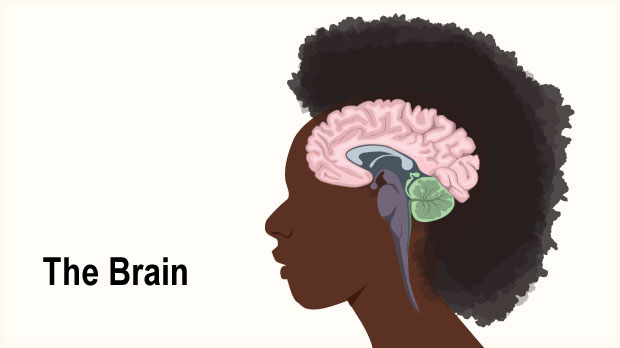
The Anatomy of the Brain
The brain is like a computer that controls the body's functions, and the nervous system is like a network that relays messages to parts of the body.
Click through this slideshow to learn more about the brain and nervous system.
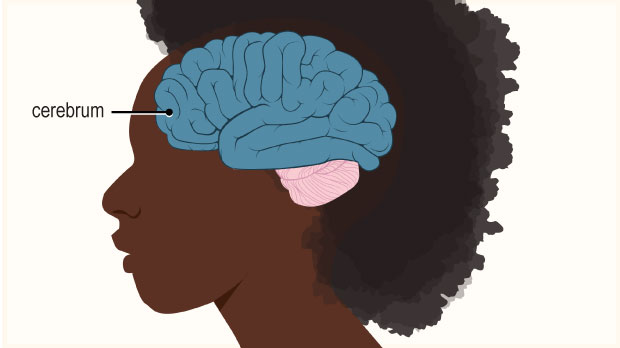
Cerebrum
The largest part of the brain, the cerebrum has two hemispheres (or halves). The cerebrum controls movement, speech, intelligence, emotion, and what we see and hear.
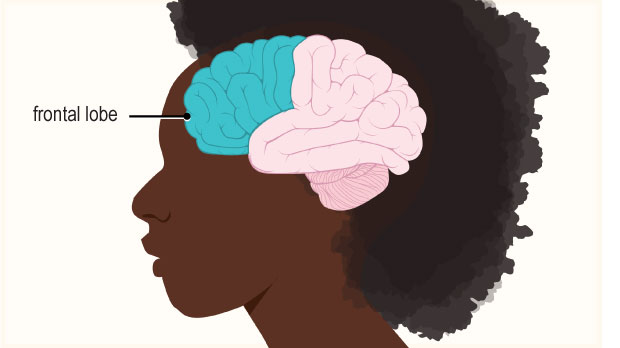
Frontal Lobe
The frontal lobe, located behind the forehead, does much of the work of complex thinking, like planning, imagining, making decisions, and reasoning.
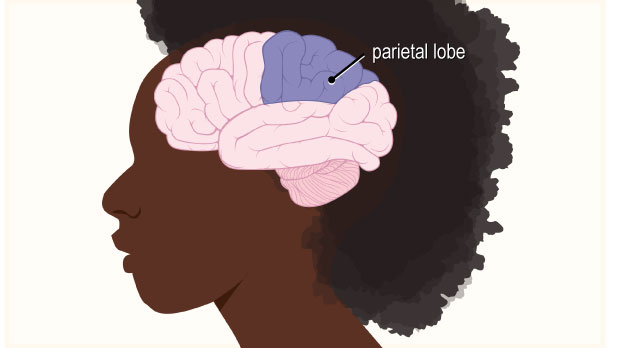
Parietal Lobe
The parietal lobe, located behind the frontal lobe, processes information about touch, taste, and temperature.
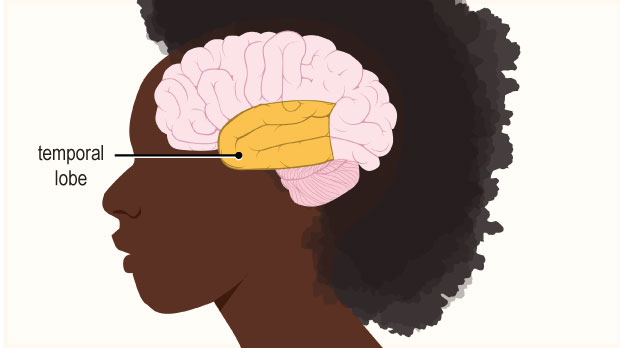
Temporal Lobe
The temporal lobe, found near the ears, lets us understand sounds and language, allows us to recognize objects and faces, and helps us create memories.
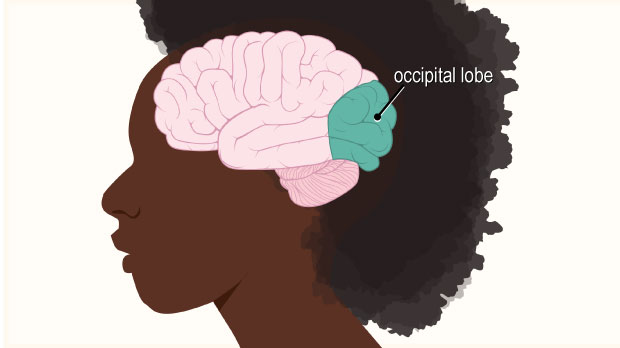
Occipital Lobe
The occipital lobe, in the rear of the brain, processes light and other visual information from the eyes, and allows us to know what we are seeing.
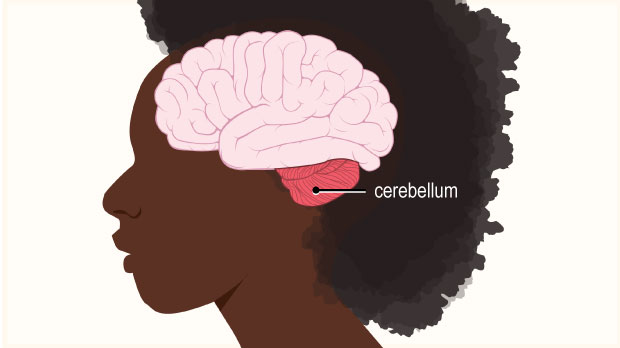
Cerebellum
The cerebellum helps coordinate and fine‑tune movement and balance.
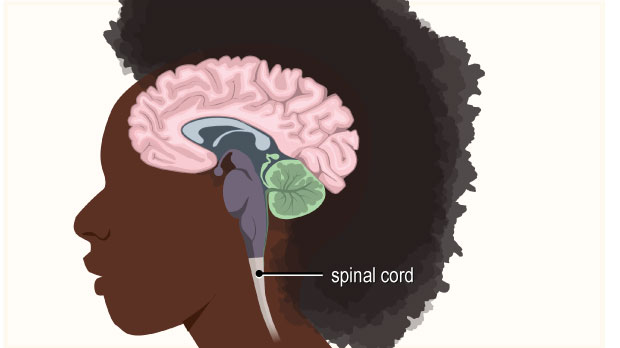
Spinal Cord
This portion of the central nervous system runs down the inside of the spinal column, connecting the brain with nerves going to the rest of the body.
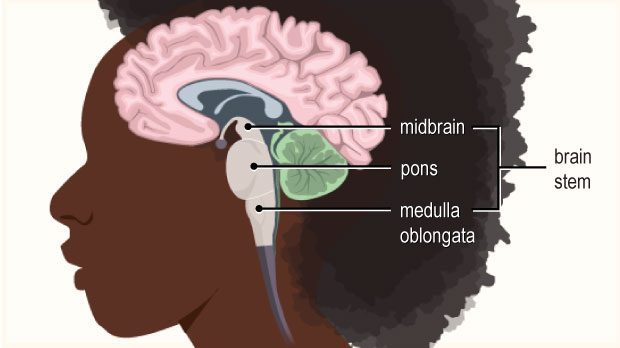
Brain Stem
At the base of the brain, the brain stem connects to the spinal cord and is made up of the midbrain, pons, and medulla oblongata.

Pons
The pons relays messages from the cerebrum to the cerebellum and spinal cord, and helps control movement of the face.
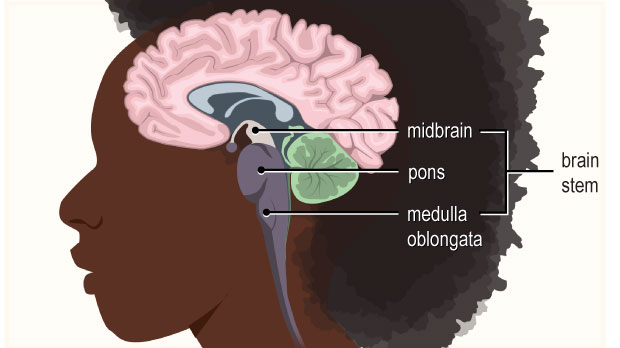
Midbrain
The midbrain helps control eye movements, and allows the brain to communicate with the rest of the nervous system.
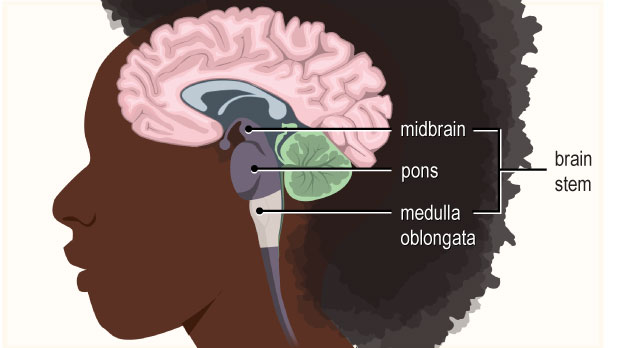
Medulla Oblongata
This portion of the brain stem is located just above the spinal cord. It regulates vital functions, such as heartbeat and breathing.

Thalamus
Located in the central part of the brain, the thalamus receives sensory messages, such as touch, from the body, and sends the messages to the appropriate part of the brain to be interpreted.
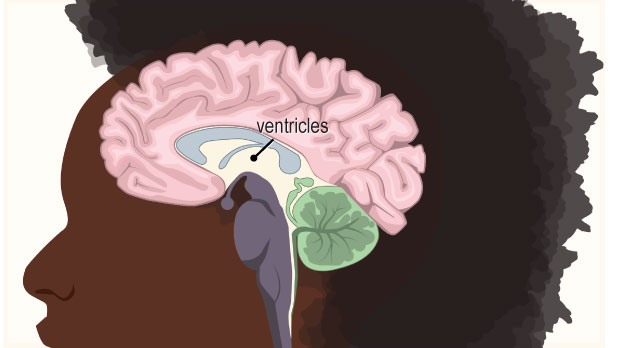
Ventricles
These hollow spaces in the brain have cerebral spinal fluid (CSF) in them. CSF flows through the ventricles and around the spine in the spinal column, protecting and nourishing the central nervous system.
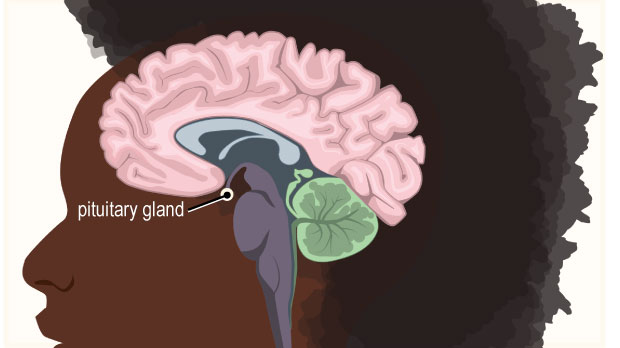
Pituitary Gland
This tiny gland produces hormones involved in regulating growth, puberty, metabolism, water and mineral balance, the body's response to stress, and more.
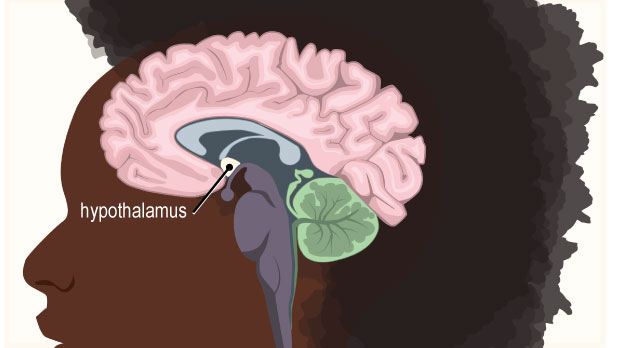
Hypothalamus
The hypothalamus regulates functions like thirst, appetite, and sleep patterns. It also regulates the release of hormones from the pituitary gland.
When a message comes into the brain from anywhere in the body, the brain tells the body how to react. For example, if you touch a hot stove, the nerves in your skin shoot a message of pain to your brain. The brain then sends a message back telling the muscles in your hand to pull away. Luckily, this neurological relay race happens in an instant.
What Are the Parts of the Nervous System?
The nervous system is made up of the central nervous system and the peripheral nervous system:
- The brain and the spinal cord are the central nervous system.
- The nerves that go through the whole body make up the peripheral nervous system.
The human brain is incredibly compact, weighing just 3 pounds. It has many folds and grooves, though. These give it the added surface area needed for storing the body's important information.
The spinal cord is a long bundle of nerve tissue about 18 inches long and 1/2-inch thick. It extends from the lower part of the brain down through spine. Along the way, nerves branch out to the entire body.
The brain and the spinal cord are protected by bone: the brain by the bones of the skull, and the spinal cord by a set of ring-shaped bones called vertebrae. They're both cushioned by layers of membranes called meninges and a special fluid called cerebrospinal fluid. This fluid helps protect the nerve tissue, keep it healthy, and remove waste products.
What Are the Parts of the Brain?
The brain has three main sections: the forebrain, the midbrain, and the hindbrain.
The Forebrain
The forebrain is the largest and most complex part of the brain. It consists of the cerebrum — the area with all the folds and grooves typically seen in pictures of the brain — as well as other structures under it.
The cerebrum contains the information that essentially makes you who you are: your intelligence, memory, personality, emotion, speech, and ability to feel and move. Specific areas of the cerebrum are in charge of processing these different types of information. These are called lobes, and there are four of them: the frontal, parietal, temporal, and occipital lobes.
The cerebrum has right and left halves, called hemispheres. They're connected in the middle by a band of nerve fibers (the corpus callosum) that lets them communicate. These halves may look like mirror images of each other, but many scientists believe they have different functions:
- The left side is considered the logical, analytical, objective side.
- The right side is thought to be more intuitive, creative, and subjective.
So when you're balancing your checkbook, you're using the left side. When you're listening to music, you're using the right side. It's believed that some people are more "right-brained" or "left-brained" while others are more "whole-brained," meaning they use both halves of their brain to the same degree.
The outer layer of the cerebrum is called the cortex (also known as "gray matter"). Information collected by the five senses comes into the brain to the cortex. This information is then directed to other parts of the nervous system for further processing. For example, when you touch the hot stove, not only does a message go out to move your hand, but one also goes to another part of the brain to help you remember not to do that again.
In the inner part of the forebrain sits the thalamus, hypothalamus, and :
- The thalamus carries messages from the sensory organs like the eyes, ears, nose, and fingers to the cortex.
- The hypothalamus controls your pulse, thirst, appetite, sleep patterns, and other processes in your body that happen automatically.
- The hypothalamus also controls the pituitary gland, which makes the that control growth, metabolism, water and mineral balance, sexual maturity, and response to stress.
The Midbrain
The midbrain, underneath the middle of the forebrain, acts as a master coordinator for all the messages going in and out of the brain to the spinal cord.
The Hindbrain
The hindbrain sits underneath the back end of the cerebrum. It consists of the cerebellum, pons, and medulla. The cerebellum — also called the "little brain" because it looks like a small version of the cerebrum — is responsible for balance, movement, and coordination.
The pons and the medulla, along with the midbrain, are often called the brainstem. The brainstem takes in, sends out, and coordinates the brain's messages. It also controls many of the body's automatic functions, like breathing, heart rate, blood pressure, swallowing, digestion, and blinking.
How Does the Nervous System Work?
The basic workings of the nervous system depend a lot on tiny cells called neurons. The brain has billions of them, and they have many specialized jobs. For example, sensory neurons send information from the eyes, ears, nose, tongue, and skin to the brain. Motor neurons carry messages away from the brain to the rest of the body.
All neurons relay information to each other through a complex electrochemical process, making connections that affect the way you think, learn, move, and behave.
Intelligence, learning, and memory. As you grow and learn, messages travel from one neuron to another over and over, creating connections, or pathways, in the brain. It's why driving takes so much concentration when someone first learns it, but later is second nature: The pathway became established.
In young children, the brain is highly adaptable. In fact, when one part of a young child's brain is injured, another part often can learn to take over some of the lost function. But as you age, the brain has to work harder to make new neural pathways, making it harder to master new tasks or change set behavior patterns. That's why many scientists believe it's important to keep challenging the brain to learn new things and make new connections — it helps keeps the brain active over the course of a lifetime.
Memory is another complex function of the brain. The things you've done, learned, and seen are first processed in the cortex. Then, if you sense that this information is important enough to remember permanently, it's passed inward to other regions of the brain (such as the hippocampus and amygdala) for long-term storage and retrieval. As these messages travel through the brain, they too create pathways that serve as the basis of memory.
Movement. Different parts of the cerebrum move different body parts. The left side of the brain controls the movements of the right side of the body, and the right side of the brain controls the movements of the left side of the body. When you press your car's accelerator with your right foot, for example, it's the left side of your brain that sends the message allowing you to do it.
Basic body functions. A part of the peripheral nervous system called the autonomic nervous system controls many of the body processes you almost never need to think about, like breathing, digestion, sweating, and shivering. The autonomic nervous system has two parts: the sympathetic nervous system and the parasympathetic nervous system.
The sympathetic nervous system prepares the body for sudden stress, like if you witness a robbery. When something frightening happens, the sympathetic nervous system makes the heart beat faster so that it sends blood quickly to the different body parts that might need it. It also causes the at the top of the kidneys to release adrenaline, a hormone that helps give extra power to the muscles for a quick getaway. This process is known as the body's "fight or flight" response.
The parasympathetic nervous system does the opposite: It prepares the body for rest. It also helps the digestive tract move along so our bodies can efficiently take in nutrients from the food we eat.
The Senses
Sight. Sight probably tells us more about the world than any other sense. Light entering the eye forms an upside-down image on the retina. The retina transforms the light into nerve signals for the brain. The brain then turns the image right-side up and tells you what you're seeing.
Hearing. Every sound you hear is the result of sound waves entering your ears and making your eardrums vibrate. These vibrations then move along the tiny bones of the middle ear and turn into nerve signals. The cortex then processes these signals, telling you what you're hearing.
Taste. The tongue contains small groups of sensory cells called taste buds that react to chemicals in foods. Taste buds react to sweet, sour, salty, bitter, and savory. The taste buds send messages to the areas in the cortex responsible for processing taste.
Smell. Olfactory cells in the mucous membranes lining each nostril react to chemicals you breathe in and send messages along specific nerves to the brain.
Touch. The skin contains millions of sensory receptors that gather information related to touch, pressure, temperature, and pain and send it to the brain for processing and reaction.